|
Related
FAQs: Neotropical
Cichlids, Neotropical Cichlids
2, Neotropical Cichlids 3,
Cichlid Fishes in
General, Cichlid Systems, Cichlid Identification, Cichlid Behavior, Cichlid Compatibility, Cichlid Selection, Cichlid Feeding, Cichlid Disease, Cichlid
Reproduction,
Related Articles: Central
American Cichlids by Neale Monks, Angelfish, Discus, Juraparoids/Eartheaters,
Convicts,
Oscars,
Firemouths,
Pike Cichlids, Crenicichla spp,
Texas
Cichlids, Flowerhorns, Dwarf South American Cichlids, Cichlids of the World,
/A Diversity of Aquatic
Life
Neotropical
Cichlid Fishes
|
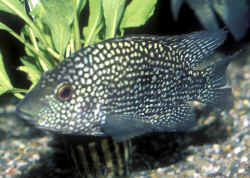
|
|
By Bob Fenner
|
Howdy Tex |
Species on Parade:
Aequidens rivulatus
(Gunther 1867), the Green Terror, an adult here at the 2014 Aq. Exp. TiffB
pic
|
%20MD.jpg)
|
Genus Amphilophus:
| Amphilophus citrinellus (Gunther 1864), the
Midas Cichlid, aka one of the Mesoamerican Cichlids called a/the
Red Devil. Nicaragua and Costa Rica, and the world through
the aquarium trade. To about ten inches in length. Can be a real
terror, bully with other livestock. |
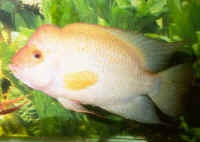
|
Bigger PIX:
The images in this table are linked
to large (desktop size) copies. Click on "framed" images
to go to the larger size. |
|
MD.jpg)
|
| Amphilophus
(formerly Cichlasoma) trimaculatus (Gunther 1867), the
three-spot Cichlid. TiffB pic at Aq Exp 2014 |
%20MD.jpg)
|
Genus Cichla:
| Cichla ocellaris Bloch & Schneider
1801, the Peacock Cichlid. Tropical South America in originally,
many places now through careless and purposeful introduction as a
food and game fish. To twenty inches, more than 5kg. Below at
two, four and eighteen inches in captivity. |
Bigger PIX:
The images in this table are linked to
large (desktop size) copies. Click on "framed" images to
go to the larger size. |
|
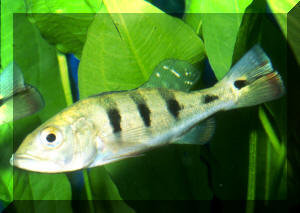
|
Genus Cichlasoma:
| Cichlasoma octofasciatum, the Jack Dempsey.
Central America; Mexico to Honduras. To ten inches (large females,
males about half this size). Shown: a new blue sport juvenile, and
a very metallic adult female. |
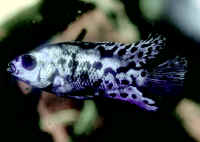 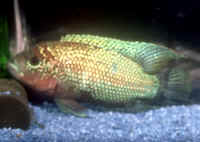
|
| Herichthys
cyanoguttatus Baird & Girard 1854, the Rio Grande or
Texas Cichlid. North America; Texas to northeastern Mexico. To a
foot total length. Aquarium images. |
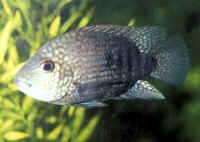 
|
| The Golden Severum, xanthic variety of the Banded
Cichlid, Heros severus Heckel 1840. Hails from the Amazon
Basin originally. To eight inches. Eats algae, plants, fruits,
seeds, detritus in the wild. A peaceful species best kept by
itself, in pairs. Conditions: pH 6-6.5, dH 4-6, temp. 23-25 C.,
though much broader in its environmental tolerance than the wild
values stated. |
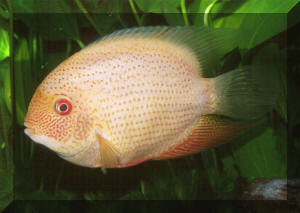
|
| Mesonauta festivus (Heckel 1840), the Flag
Cichlid. South America; Orinoco to Paraguay. To six inches in
length. An old standard in the more peaceful medium sized cichlids
in the aquarium interest. |
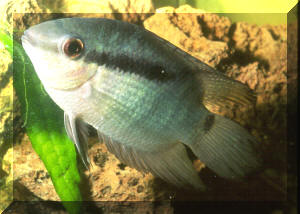
|
Genus Nandopsis:
| Nandopsis managuense (Gunther 1867), the Managuense
Cichlid. TiffB pic from Aq. Exp. 2014 |
%20MD.jpg)
|
Genus Thorichthys:
| Thorichthys aureus Gunther 1862, the Blue
Flash Cichlid. Central America; Atlantic Slope, Belize (Golden
Creek) to Honduras (Motagua River basin). To 15 cm. in length.
Cond.s: pH to 7.5, DH 2-15, Temp. 24-28 C. Aquarium photo.
|
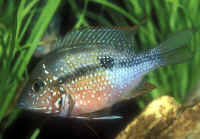
|
| Thorichthys
meeki Brind 1918, the Firemouth Cichlid. Central America;
Atlantic Slope. To 17 cm. in length. Feeds primarily on algae in
the wild. Utilized in behavioral studies and monster truck
ads. |
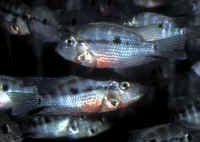
|
| Uaru
amphiacanthoides Heckel 1840, the Uaru or Triangle Cichlid.
To ten inches in length. pH range: 5.0 - 7.0; dH range: 5.0 - 12.0,
temp.: 26-28 C. South America: Rio Amazonas basin, along the
Rio Amazonas-Solimões drainage from the Rio
Japurá to the Rio Tapajós, and in the middle
and lower Rio Negro in slow moving streams. Feeds on insects,
crustaceans and plants. |
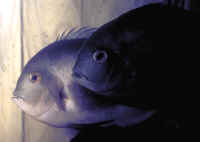
|
Hybrids... Beautiful Mutants,
Crosses
| The Parrot Cichlid. Perhaps a mix between
Amphilophus citrinellum (the Midas Cichlid) and
Cichlasoma synspilum (the Redhead Cichlid), this hybrid was
produced first in the mid-1980's in Taiwan. Other possible
"donor" species include: Heros severus (the
Severum) and one of the Red Devils (Amphilophus
labiatum). To eight inches in length. Beauty is indeed, in the
eye of the beholder. This one on show at the 6/01 Aquarama Show in
Singapore. http://www.geocities.com/parrotcichlid/main.html,
and a batch of juveniles there... |
|
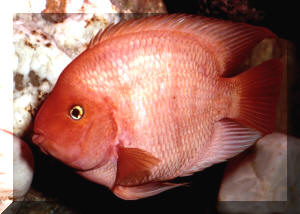
|
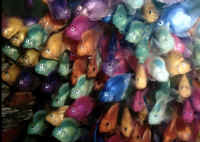
|
| A dihybrid "new cichlid" out of the Far
East... this pic shot a month back at the Aquarama show in
Singapore... is likely (my guess) a Vieja (formerly
Cichlasoma) maculicauda (Black Belt) and
Cichlasoma trimaculatum cichlid cross... a beauty,
but still a
cross.
Re: What is this "new cichlid"? Something bifasciatum?
Not according to fishbase.org Bob, This fish will sell well in
Singapore or in a Buddhist country. The bump on the head resembles
the forehead of one of the Buddhist Arhats by the name of Luo Han.
Imagine owning a fish that reminds you of a Buddhist deity that you
are worshipping. Will bring plenty of good luck and fortune. Perry
<Thanks for this Perry. Will post with image on our sites. Bob
Fenner> Re: What is this "new
cichlid"? Dear Bob, our expert for American cichlids
Uwe Werner wrote me, that he feels the cichlid is not a natural
form, but an Asian-bred form of Cichlasoma amphilophus. He says
that there is total red specimens too. Here in Germany the sun is
shining like in Southern California. Take care Werner <Ah, danke
shoen. Will post your input to this image on our site
(www.WetWebMedia.com). More images, articles on their way to you at
das Aquarium. Wiedersen. Bob Fenner> |
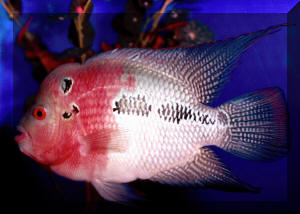
|
|
Kirin (not the beer) Hi! How is everyone this evening?
Good I hope. <Very well!> I was just browsing the web for
info on my new baby Texas Cichlids, and I came across a website
dedicated to that new hybrid you have a pic of in the section on
neo tropical cichlids. According to the info on the site,
it's a Kirin. And yes, it is a hybrid. It's a
Cyanoguttatum or Carpinte and Trimaculatus cross. It's
supposed to bring prosperity with it's bump head, good
fortune with it's jeweled speckles symbolizing wealth, and
scare away evil spirits with its red eyes. The website address is
www.kirin.com.sg/species.html Just what the world needs, another
cichlid hybrid from the far east. At least it's not as
hideously ugly as the parrot fish. SMILE). I have a parrotfish
myself, and I love his funny looking little face. Goodnight,
Kristen:) <Beauty is in the eye of the beholder. There are
some truly striking looking fish on that webpage, though. -Steven
Pro>
|
|
Excerpted from: Forgotten Fish; Old-timers
with plenty to offer by Neale
Monks
Forgotten cichlids
Of course as a group the cichlids are far
from forgotten, with many species being among the most popular
fish in the hobby. From the elegant angels of the Amazon to the
feisty Rift Valley species from Africa, the cichlids have firmly
established themselves as the most intelligent and engaging of
all the fish kept by hobbyists. Nonetheless, there are a
surprising number of species that have somehow fallen out of
favor. One of the loveliest is the keyhole cichlid,
Cleithracara maronii, a gentle species perfectly suited to
life in a community tank. The main problem with this fish is its
lack of color: basically yellowy-brown with black markings on the
head and flanks, compared with the brilliant blues and yellows of
the average African cichlid, the poor old keyhole does rather
lose out. But on the flip side, this is a small species (around
3" or so) that barely digs and never harasses tankmates.
Gentle almost to the point of shyness, this is a splendid choice
for the aquarist who wants to observe cichlid behavior without
disrupting the serenity of a South American-themed community of
tetras and Corydoras catfish. While it prefers soft and
acid water for breeding purposes, the keyhole is very adaptable
and will do well in even fairly hard and basic water
conditions.
Another South American cichlid that has lost
some of its popularity over the years is Laetacara
curviceps, the flag acara. A smaller fish than even the
keyhole cichlid, the flag acara is an excellent community tank
resident. A master of color changes even by cichlid standards, a
flag acara can switch from tan to green to blue in seconds.
Superimposed on its basic coloration is black band running along
the midline of the fish, though this can fade away to practically
nothing depending on the mood of the fish. All in all, these are
interesting fish to watch. They are also surprisingly adaptable
and easy to tame for such small fish, and once settled in can be
fed by hand. Perhaps overshadowed by the more brightly colored
Apistogramma species from South America and the showy
dwarf cichlids like the krib from West Africa, like so many of
the old-timers of the aquarium hobby, it is a fish well worth
rediscovering.
|
Bibliography/Further Reading:
Leibel, Wayne S. 1993. A Fishkeeper's Guide to South American
Cichlids. A splendid survey of this attractive and diverse group of
freshwater tropical fishes. Tetra Press, Blacksburg, VA.
Loiselle, Paul V. 1985. The Cichlid Aquarium. Tetra Press, Melle
Germany.
|
|

